Summary
Calorimetry makes it possible to determine the enthalpies of combustion for substances whose heat of formation cannot be found directly. The purpose of this experiment was to determine the enthalpy of combustion of Mickey Mouse Clubhouse in kilojoules using a bomb calorimeter. Benzoic acid was used as the calorimetric standard to determine the instrument’s heat capacity, which was found to be 8.89 KJ/K. This value was used to compute the heat of combustion of the candy that was found to be -16.18 KJ. The experimental and manufacturer’s enthalpies of the candy were compared statistically. No significant differences were seen between the two values at a 95% confidence interval. It was concluded that bomb calorimetry was an accurate and efficient method of determining the enthalpy of combustion of a high-energy candy.
Introduction
Physical chemists are interested in determining the chemical energy contained in various chemical substances. One way of determining the chemical energy of a substance is using the heat of formation, which may be defined as the sum of heat that is taken in or liberated when a substance is formed from its constituent elements at standard volume and pressure.1 These heats may be negative or positive depending on the internal energy of the substance with respect to its constituent elements. At constant pressure, the heat obtained through this procedure is referred to as enthalpy (ΔH) of the reaction. At constant volume, the heat of formation per mole of a compound formed, which can be found from alterations in temperature, is the energy of the reaction and is denoted by ΔU. Equation 1 can be used to compute ΔU as follows.
ΔU = Cv ΔT[1]
In equation 1, Cv is the heat capacity of the substance, whereas ΔT is the temperature difference obtained by subtracting Tinitial from Tfinal.
However, this experimental approach may not be feasible for all chemical compounds because some compounds are not formed directly from their chemical constituents. Nonetheless, alternative experimental approaches can be used to calculate the heat of formation. These procedures are based on heats of combustion and Hess’ law of constant heat summation, which states that the entire enthalpy change for a reaction is equal to the sum of the enthalpies of the individual steps notwithstanding the number of steps in the reaction.2
Calorimetry is an experimental procedure that quantifies the amount of heat absorbed or liberated during chemical reactions.3 A calorimeter is a piece of special equipment that is used for this function. A bomb calorimeter operates at a constant volume, which implies that the heat obtained using this instrument is equivalent to the internal heat of a substance. The purpose of this experiment was to use calorimetry to determine the calories of a high-sugar candy using enthalpy of combustion.
Methods
Two experimental runs were made using 1.0 g portions of benzoic acid to determine the heat capacity of the calorimeter system. In this case, the benzoic acid was referred to as the calorimetric standard. Thereafter, the calorimeter was prepared by flushing with oxygen to remove residual nitrogen. Experimental runs were conducted for 10 to 20 minutes with data collection being done at 30-second intervals before ignition and 5 to 10-second intervals following ignition. Changes in combustion temperatures were determined by finding the difference between pre-ignition temperature and post-ignition temperature.
The actual change in temperature due to combustion was determined by plotting temperature versus time and extrapolating to remove temperature changes due to stirring and environmental loss. The heat capacity of the calorimeter system, C(C), was found by determining the temperature rise (T2 – T1) obtained from the combustion of the known masses of benzoic acid and iron wire. The energy change for the combustion of candy is determined from the rise in temperature (T2 – T1) and the average value of C(C), determine from the two trials with benzoic acid.
Results
Two experimental runs were performed for each experiment. Figures 1, 3, and 4 illustrate sample plots obtained from the combustion reaction of benzoic acid, the first order best line of fit for the flat portion before ignition and after ignition. Other data sets that were collected data included the temperature changes for the combustion experiments for benzoic acid and the candy, which were 3.15oK ± 0.01 (Appendix 1) and 1.831oK ± 0.01 (Appendix 3), respectively as indicated in Table 1. The heat capacity of the calorimeter was then calculated using the known combustion energies of benzoic acid and wire as indicated in Table 2 and was found to be 8.89 KJ/K (Appendix 3). The temperatures recorded in Table 1 were used to calculate the heat of combustion of Mickey Mouse Clubhouse in kilojoules (Appendix 4), which was found to be -16.18 KJ as shown in Table 3. Statistical comparison was done between experimental and manufacturer enthalpies (kcal) of Mickey Mouse Clubhouse Candy at a 95% confidence interval (Appendix 5). Specific parameters that were computed included mean (3.87), standard deviation (0.113), absolute error between experimental and manufacturer (0.13), and % error (3.25). All these values are summarized in Table 4.
Combustion experiments for benzoic acid
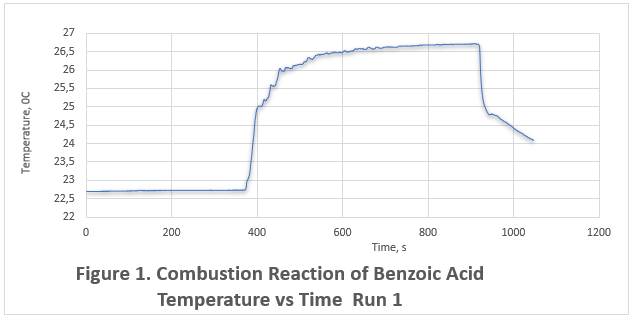
The best fit line (first order) for the flat portion of the curve before ignition
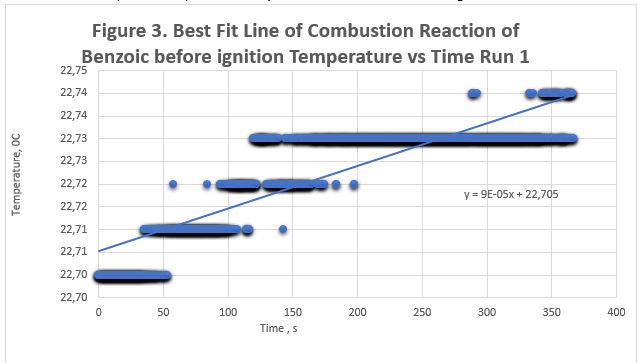
The best fit line (first order) for the flat portion of the curve for the flat portion of the curve after the combustion has occurred.
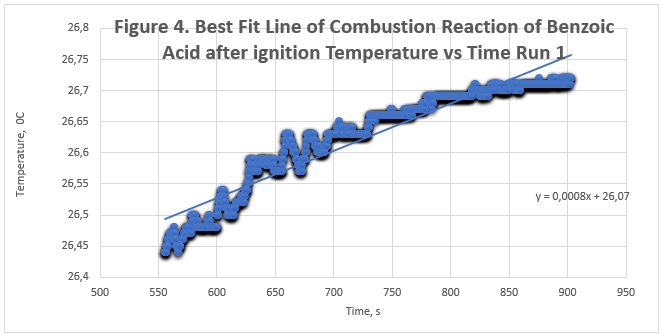
Table 1: Temperature Changes due to Combustion Reaction of Benzoic Acid and Mickey Mouse Clubhouse Candy.
Table 2: Calculation of heat capacity of calorimeter using the known combustion energies of benzoic acid and wire.
Table 3: Calculation of heat of combustion of Mickey Mouse Clubhouse in kilojoules.
Table 4: Statistical comparison between experimental kcal and Manufacturer kcal of Mickey Mouse Clubhouse Candy
Possible sources of error in the experiment are linked to experimental procedures such as errors during the measurement of water, weighing of benzoic acid and the candy, as well as pressure variations when pressurizing or venting the bomb calorimeter.3 The thermometer readings could also contribute to errors in the overall results. The volume of water was measured using the human eye, which could result in meniscus errors, thus affecting the accuracy of the water volumes. It was also likely that the source of heat in the calorimeter was not the combustion of the solids alone. The stirring effect generated some heat in the calorimeter, which contributed to the overall heat.4 On the other hand, part of the heat could have escaped from the calorimeter by dissipating through the walls.
It was suggested that the same amount of water was used in the calorimeter for each run. Varying the amount of water in the calorimeter introduces variations in the effective volume during the experiment as well as the ensuing pressure.4 Consequently, the reactions will not occur at the same volume and pressure that interfering with the accuracy and precision of the values recorded in different experimental runs.
It is advisable to try and get the same O2(g) pressure in the bomb for each run to minimize variations in the resultant enthalpy. When calculating the enthalpy of a reaction, it is assumed that the combustion is taking place at constant volume and pressure. Therefore, varying the pressures at different experimental runs would lead to varying enthalpies and affect the precision of the experiment.4 Nonetheless, it can be said that the experiment is run under constant volume conditions. The volume of the calorimeter is fixed. Furthermore, any additional changes in the volume within the calorimeter are minimized by using the same volume of water. However, as much as the investigator attempts to obtain constant pressure during the experimental runs, there is a likelihood of slight variations in pressure, which is responsible for the differences in the calculated heats of combustion.
The absolute error between the experimental and literature value for the calories of the candy was 0.13. On the other hand, the percent error was 3.25%. The experimental uncertainties identified in the procedure, for example, the inability to guarantee exact pressures at each run, were responsible for the errors. However, the published value was within the 95% confidence interval. Therefore, it was concluded that the experimental kcal calories were not significantly different from the manufacturer’s value.
Conclusion and Recommendation
Through this experiment, it was possible to determine the enthalpy of combustion of Mickey Mouse Clubhouse Candy sample after the combustion of benzoic acid was done to determine the Ccal value, which was 8.89 KJ/K, and the enthalpy of combustion of the candy was found to be 1.83 ± 0.01. A statistical analysis of the manufacturer and experimental enthalpy of combustion of the candy yielded a mean of 3.87, a standard deviation of 0.113, an absolute error of 0.13, and a % error (3.25) at the 95% confidence interval. These findings showed that there was no significant difference between the experimental and reported enthalpy of combustion for the candy. It was concluded that bomb calorimetry is a reliable technique in the determination of enthalpies of combustion and should be used under experimental conditions in the laboratory.
Appendices
Temperature Changes due to Combustion Reaction of Benzoic Acid

Calculation of heat capacity of calorimeter using the known combustion energies of benzoic acid and wire
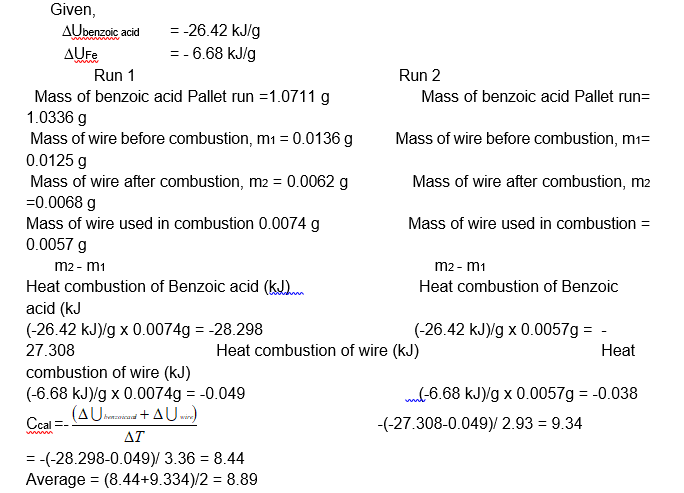
Temperature Changes due to Combustion Reaction of Mickey Mouse Clubhouse

Calculation of energy of combustion of Mickey Mouse Clubhouse in kilojoules
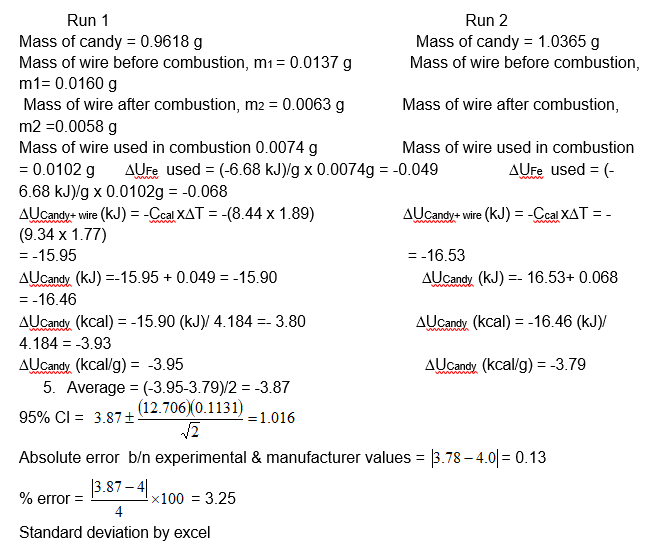
References
Agne, M.T.; Barsoum, M.W. Enthalpy of Formation and Thermodynamic Parameters of the MAX Phase V2AlC. J. Alloy Compd. 2016, 665, 218-224.
Spera, D.Z.; Liebman, J.F. Paradigms and Paradoxes: Hess’ Law and the Thermodynamic Validity of Jolly’s Method for Estimating Bond Dissociation Energies. Struct. Chem. 2018, 29, 1589-1591.
Guo, H.; Lyon, R.E.; Safronava, N. Accuracy of Heat-Release Rate Measured in Microscale Combustion Calorimetry. J. Test. Eval. 2017, 46, 1-9.
Kantonen, S.A.; Henriksen, N.M.; Gilson, M.K. Accounting for Apparent Deviations Between Calorimetric and Van’t Hoff Enthalpies. BBA-Gen. Subjects. 2018, 1862, 692-704.